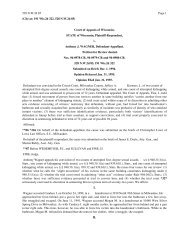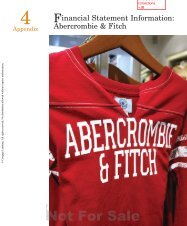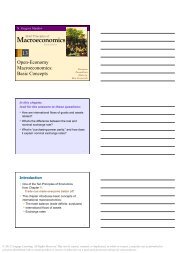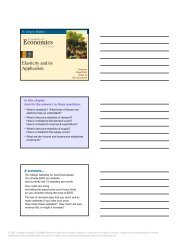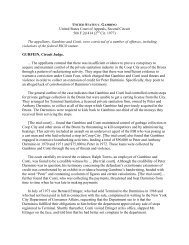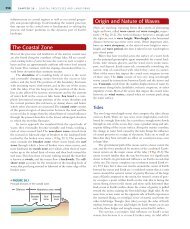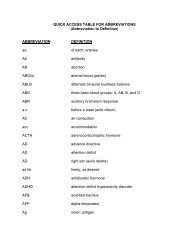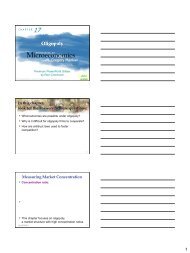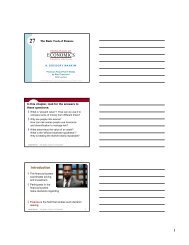Economics - Cengage Learning
Economics - Cengage Learning
Economics - Cengage Learning
You also want an ePaper? Increase the reach of your titles
YUMPU automatically turns print PDFs into web optimized ePapers that Google loves.
N. Gregory Mankiw<br />
Principles of<br />
<strong>Economics</strong><br />
Sixth Edition<br />
3<br />
Interdependence and the<br />
Gains from Trade Premium<br />
PowerPoint<br />
Slides by<br />
Ron Cronovich<br />
In this chapter,<br />
look for the answers to these questions:<br />
• Why do people—and nations—choose to be<br />
economically interdependent?<br />
• How can trade make everyone better off?<br />
• What is absolute advantage?<br />
What is comparative advantage?<br />
How are these concepts similar?<br />
How are they different?<br />
Interdependence<br />
Every day<br />
you rely on<br />
many people<br />
from around<br />
the world,<br />
most of whom<br />
you’ve never met,<br />
to provide you<br />
with the goods<br />
and services<br />
you enjoy.<br />
© 2012 <strong>Cengage</strong><strong>Learning</strong>. All Rights Reserved. May not be copied, scanned, or duplicated, in whole or in part, except for use as permitted in alicense<br />
distributed with a certain product or service or otherwise on a password-protected website for classroom use.<br />
1
Interdependence<br />
§ One of the Ten Principles from Chapter 1:<br />
Trade can make everyone better off.<br />
§ We now learn why people—and nations—<br />
choose to be interdependent,<br />
and how they can gain from trade.<br />
Our Example<br />
§ Two countries: the U.S. and Japan<br />
§ Two goods: computers and wheat<br />
§ One resource: labor, measured in hours<br />
§ We will look at how much of both goods<br />
each country produces and consumes<br />
§ if the country chooses to be self-sufficient<br />
§ if it trades with the other country<br />
Production Possibilities in the U.S.<br />
§ The U.S. has 50,000 hours of labor<br />
available for production, per month.<br />
§ Producing one computer<br />
requires 100 hours of labor.<br />
§ Producing one ton of wheat<br />
requires 10 hours of labor.<br />
© 2012 <strong>Cengage</strong><strong>Learning</strong>. All Rights Reserved. May not be copied, scanned, or duplicated, in whole or in part, except for use as permitted in alicense<br />
distributed with a certain product or service or otherwise on a password-protected website for classroom use.<br />
3<br />
4<br />
5
Wheat<br />
(tons)<br />
5,000<br />
4,000<br />
3,000<br />
2,000<br />
1,000<br />
0<br />
Wheat<br />
(tons)<br />
5,000<br />
4,000<br />
3,000<br />
2,000<br />
1,000<br />
0<br />
100<br />
100<br />
The U.S. PPF<br />
200 300 400<br />
200 300 400<br />
Computers<br />
500<br />
The U.S. Without Trade<br />
ACTIVE LEARNING 1<br />
Derive Japan’s PPF<br />
Suppose the U.S. uses half its labor<br />
to produce each of the two goods.<br />
Then it will produce and consume<br />
Computers<br />
500<br />
Use the following information to draw Japan’s PPF.<br />
§ Japan has 30,000 hours of labor available for<br />
production, per month.<br />
§ Producing one computer requires 125 hours of<br />
labor.<br />
§ Producing one ton of wheat requires 25 hours<br />
of labor.<br />
Your graph should measure computers on the<br />
horizontal axis.<br />
© 2012 <strong>Cengage</strong><strong>Learning</strong>. All Rights Reserved. May not be copied, scanned, or duplicated, in whole or in part, except for use as permitted in alicense<br />
distributed with a certain product or service or otherwise on a password-protected website for classroom use.<br />
6<br />
7
Wheat<br />
(tons)<br />
2,000<br />
1,000<br />
0<br />
Wheat<br />
(tons)<br />
2,000<br />
1,000<br />
0<br />
Japan’s PPF<br />
100 200 300<br />
Computers<br />
Japan Without Trade<br />
Suppose Japan uses half its labor to<br />
produce each good.<br />
Then it will produce and consume<br />
100 200 300<br />
Computers<br />
Consumption With and Without Trade<br />
§ Without trade,<br />
§ U.S. consumers get _____ computers<br />
and ______ tons wheat.<br />
§ Japanese consumers get ____ computers<br />
and _____ tons wheat.<br />
§ We will compare consumption without trade to<br />
consumption with trade.<br />
§ First, we need to see how much of each good is<br />
produced and traded by the two countries.<br />
© 2012 <strong>Cengage</strong><strong>Learning</strong>. All Rights Reserved. May not be copied, scanned, or duplicated, in whole or in part, except for use as permitted in alicense<br />
distributed with a certain product or service or otherwise on a password-protected website for classroom use.<br />
9<br />
10<br />
11
ACTIVE LEARNING 2<br />
Production under trade<br />
1. Suppose the U.S. produces 3400 tons of wheat.<br />
How many computers would the U.S. be able to<br />
produce with its remaining labor? Draw the<br />
point representing this combination of<br />
computers and wheat on the U.S. PPF.<br />
2. Suppose Japan produces 240 computers.<br />
How many tons of wheat would Japan be able<br />
to produce with its remaining labor? Draw this<br />
point on Japan’s PPF.<br />
Wheat<br />
(tons)<br />
5,000<br />
4,000<br />
3,000<br />
2,000<br />
1,000<br />
0<br />
Wheat<br />
(tons)<br />
2,000<br />
1,000<br />
0<br />
U.S. Production With Trade<br />
100<br />
200 300 400<br />
Computers<br />
500<br />
Japan’s Production With Trade<br />
100 200 300<br />
Computers<br />
© 2012 <strong>Cengage</strong><strong>Learning</strong>. All Rights Reserved. May not be copied, scanned, or duplicated, in whole or in part, except for use as permitted in alicense<br />
distributed with a certain product or service or otherwise on a password-protected website for classroom use.<br />
13<br />
14
Exports & Imports<br />
§ Exports:<br />
goods produced domestically and sold abroad<br />
To export means to sell domestically produced<br />
goods abroad.<br />
§ Imports:<br />
goods produced abroad and sold domestically<br />
To import means to purchase goods produced<br />
in other countries.<br />
ACTIVE LEARNING 3<br />
Consumption under trade<br />
Suppose the U.S. exports 700 tons of wheat to<br />
Japan, and imports 110 computers from Japan.<br />
(So, Japan imports 700 tons wheat and exports<br />
110 computers.)<br />
§ How much of each good is consumed in the<br />
U.S.? Plot this combination on the U.S. PPF.<br />
§ How much of each good is consumed in<br />
Japan? Plot this combination on Japan’s PPF.<br />
Wheat<br />
(tons)<br />
5,000<br />
4,000<br />
3,000<br />
2,000<br />
1,000<br />
0<br />
U.S. Consumption With Trade<br />
100<br />
200 300 400<br />
produced<br />
+ imported<br />
–exported<br />
= amount<br />
consumed<br />
computers<br />
160<br />
Computers<br />
500<br />
3400<br />
© 2012 <strong>Cengage</strong><strong>Learning</strong>. All Rights Reserved. May not be copied, scanned, or duplicated, in whole or in part, except for use as permitted in alicense<br />
distributed with a certain product or service or otherwise on a password-protected website for classroom use.<br />
15<br />
wheat<br />
17
Wheat<br />
(tons)<br />
2,000<br />
1,000<br />
0<br />
Japan’s Consumption With Trade<br />
produced<br />
+ imported<br />
–exported<br />
= amount<br />
consumed<br />
100 200 300<br />
computers<br />
240<br />
Computers<br />
wheat<br />
Trade Makes Both Countries Better Off<br />
computers<br />
wheat<br />
computers<br />
wheat<br />
consumption<br />
without trade<br />
250<br />
2500<br />
consumption<br />
without trade<br />
120<br />
600<br />
U.S.<br />
Japan<br />
consumption<br />
with trade<br />
consumption<br />
with trade<br />
0<br />
gains from<br />
trade<br />
gains from<br />
trade<br />
Where Do These Gains Come From?<br />
§ Absolute advantage:<br />
§ The U.S. has an absolute advantage in wheat:<br />
§ If each country has an absolute advantage<br />
in one good and specializes in that good,<br />
then both countries can gain from trade.<br />
© 2012 <strong>Cengage</strong><strong>Learning</strong>. All Rights Reserved. May not be copied, scanned, or duplicated, in whole or in part, except for use as permitted in alicense<br />
distributed with a certain product or service or otherwise on a password-protected website for classroom use.<br />
18<br />
19<br />
20
Where Do These Gains Come From?<br />
§ Which country has an absolute advantage in<br />
computers?<br />
So why does Japan specialize in computers?<br />
Why do both countries gain from trade?<br />
Two Measures of the Cost of a Good<br />
§ Two countries can gain from trade when each<br />
specializes in the good it produces at lowest cost.<br />
§ Absolute advantage measures the cost of a good<br />
in terms of<br />
§ Recall:<br />
Another measure of cost is opportunity cost.<br />
§ In our example,<br />
the opportunity cost of a computer is<br />
Opportunity Cost and<br />
Comparative Advantage<br />
§ Comparative advantage:<br />
§ Which country has the comparative advantage in<br />
computers?<br />
§ To answer this, must determine the opportunity<br />
cost of a computer in each country.<br />
© 2012 <strong>Cengage</strong><strong>Learning</strong>. All Rights Reserved. May not be copied, scanned, or duplicated, in whole or in part, except for use as permitted in alicense<br />
distributed with a certain product or service or otherwise on a password-protected website for classroom use.<br />
21<br />
22<br />
23
Opportunity Cost and<br />
Comparative Advantage<br />
§ The opportunity cost of a computer is<br />
§ ______ tons of wheat in the U.S., because<br />
§ ______ tons of wheat in Japan, because<br />
§ So, _________ has a comparative advantage in<br />
computers.<br />
Lesson:<br />
Comparative Advantage and Trade<br />
§<br />
§ When each country specializes in the good(s)<br />
in which it has a comparative advantage,<br />
total production in all countries is higher,<br />
the world’s “economic pie” is bigger,<br />
and all countries can gain from trade.<br />
§ The same applies to individual producers<br />
(like the farmer and the rancher) specializing<br />
in different goods and trading with each other.<br />
ACTIVE LEARNING 4<br />
Absolute and comparative advantage<br />
Argentina and Brazil each have 10,000 hours of<br />
labor per month.<br />
In Argentina,<br />
§ producing one pound coffee requires 2 hours<br />
§ producing one bottle wine requires 4 hours<br />
In Brazil,<br />
§ producing one pound coffee requires 1 hour<br />
§ producing one bottle wine requires 5 hours<br />
Which country has an absolute advantage in the<br />
production of coffee? Which country has a<br />
comparative advantage in the production of wine?<br />
© 2012 <strong>Cengage</strong><strong>Learning</strong>. All Rights Reserved. May not be copied, scanned, or duplicated, in whole or in part, except for use as permitted in alicense<br />
distributed with a certain product or service or otherwise on a password-protected website for classroom use.<br />
24<br />
25
ACTIVE LEARNING 4<br />
Answers<br />
Unanswered Questions…<br />
§ We made a lot of assumptions about the quantities<br />
of each good that each country produces, trades,<br />
and consumes, and the price at which the countries<br />
trade wheat for computers.<br />
§ In the real world, these quantities and prices would<br />
be determined by<br />
§ We will begin to study this in the next chapter.<br />
§ For now, though, our goal was merely to<br />
see how trade can make everyone better off.<br />
© 2012 <strong>Cengage</strong><strong>Learning</strong>. All Rights Reserved. May not be copied, scanned, or duplicated, in whole or in part, except for use as permitted in alicense<br />
distributed with a certain product or service or otherwise on a password-protected website for classroom use.<br />
28



